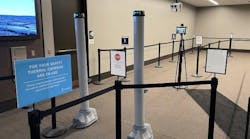PITTSBURGH, Dec. 19. - MSA announced today that it has secured a contract to furnish Florida emergency response agencies with a line of hazard detection systems that will be used to enhance the state's already formidable homeland security and HazMat response capabilities. The contract includes the largest order to date for MSA's SAFESITE Multi-Threat Detection System, a new wireless system designed for perimeter monitoring at public events, as well as monitoring of mass transit systems, shipping ports and other facilities that could be the target of a terrorist incident.
As part of this initiative, the state of Florida also will be deploying several Sirius handheld multi-gas detectors from MSA that will be used by first responder personnel called to emergency situations. The Sirius detectors feature the ability to communicate wirelessly to the SAFESITE System through an innovative Bluetooth module, providing complete system interoperability.
The selection of the SAFESITE System marks the culmination of a one-year evaluation process in which state officials assessed a variety of new technologies and systems.
Ron Rogers, Special Operations Chief for Hillsborough County (Fla.) Fire Rescue, and Dan Wouters, HazMat Coordinator for Martin City (Fla.) Fire and Rescue, oversaw and coordinated the evaluation process. "The major factors we considered were sensing capabilities, range, reliability, wireless capability and communications effectiveness," Mr. Wouters said.
He explained that the selection process included multiple system demonstrations and a field verification test of systems within Hillsborough County. Mr. Wouters, who also serves as Chairman of the Florida Association of HazMat Responders, added that the MSA systems will be deployed throughout the state covering some 30 counties, including major metropolitan areas such as Miami-Dade, Orlando and Jacksonville.
"The fundamental goal of our evaluation process was to equip our specialized hazardous materials teams with an interoperable, functional and effective system," Mr. Wouters commented. "It's likely most people will see the homeland security benefits of having this technology as the most intriguing. And that is understandable given the large number of high-profile sporting and entertainment events Florida hosts on an annual basis. But realistically we are looking to these systems to equally enhance our capabilities when called to respond to more common incidents, such as HazMat spills and accidents involving industrial chemicals."
The SAFESITE System, which operates within a wireless network, is designed to detect and communicate the presence of up to six potential hazards, including chemical warfare agents (CWA), gamma radiation, toxic industrial chemicals, volatile organic compounds, combustible gases and oxygen deficiency and enrichment.
The system consists of two main components; the SAFEMTX Multi-Threat Detector and the SAFECOM Command Center. Depending on the situation, the system can be installed permanently (wired or wireless) for continuous monitoring, or deployed as a portable system.
MSA developed the concept for the SAFESITE System in late 2003. Since then, it has been deployed and tested in numerous high-profile venues, including the Kentucky Derby, the annual New Years Eve celebration in New York's Times Square, the 2004 Democratic National Convention and the 2004 Summer Olympics in Greece.
In operation, the SAFECOM Command Center converts data from the SAFEMTX Detectors into practical information through an uncomplicated graphical user interface, enabling rapid decision-making. SAFECOM Command Centers can manage up to two systems with 16 SAFEMTX Detectors per system.
"We are pleased to have an opportunity to work with the state of Florida and their emergency responders in this capacity and are grateful for their trust in MSA," said Kerry Bove, Vice President and General Manager of MSA's Instrument Division. "As the safety equipment needs of the homeland security market shift from that of protection to detection, systems like SAFESITE will help ensure that local and state emergency response agencies meet Department of Homeland Security guidelines for dealing with a terrorist attack," Mr. Bove said.
Established in 1914, MSA is a global leader in the development, manufacture and supply of sophisticated safety products that protect people's health and safety. Sophisticated safety products typically integrate any combination of electronics, mechanical systems and advanced materials to protect users against hazardous or life-threatening situations. The company's comprehensive line of products is used by workers around the world in the fire service, homeland security, construction and other industries, as well as the military. Principal products include self-contained breathing apparatus, gas masks, gas detection instruments, head protection, respirators and thermal imaging cameras. The company also provides a broad range of consumer and contractor safety products through retail channels. These products are marketed and sold under the MSA Safety Works brand. MSA has annual sales of more than $850 million, manufacturing operations throughout the United States and Europe, and more than 30 international locations. Additional information is available on the company's website at www.msanet.com.

